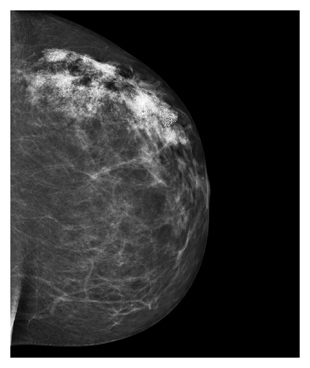Recente nieuwsberichten
Borstkanker door bewaren gsm in BH
- Gegevens
- Geschreven: donderdag 20 augustus 2015 11:31
 cbsnews.com - Dr. John West, diensthoofd chirurgie van een borstkankerkliniek in Californië meent dat het bewaren van een gsm / smartphone dicht op het lichaam, kanker kan veroorzaken.
cbsnews.com - Dr. John West, diensthoofd chirurgie van een borstkankerkliniek in Californië meent dat het bewaren van een gsm / smartphone dicht op het lichaam, kanker kan veroorzaken.
Hij werd in zijn praktijk geconfronteerd met verschillende jonge vrouwen die de gewoonte hadden om hun gsm te bewaren in hun BH en die borstkanker ontwikkelden net onder de plaats waar ze hun gsm bewaarden. De mammografie toonde steeds een afwijkend, rechthoekig patroon waarbij de vorm en grootte van de kanker opvallend overeenkwam met die van de gsm (zie foto).
Eén van zijn patiënten was Shea Hartman, die in 2012 op 21-jarige leeftijd werd gediagnosticeerd met een invasieve borstkanker. De kwaadaardige tumor had een afmeting van 3.5 op 9.5 centimeter, ongeveer de grootte van haar Samsung Alias gsm.
Dr. West en zijn team documenteerden reeds 32 dergelijke gevallen. Ze publiceerden er ook een wetenschappelijke studie over in 2013.
Bijschrift bij de foto: "Shea Hartman's left mammogram shows clustered calcifications corresponding to multiple sites of disease in craniocaudal and mediolateral oblique projections. (November 2012) - Dr. John West"
Could a warning make a difference?
http://www.cbsnews.com/news/cellphone-safety-right-to-know/
Dr. John West, director of surgery at the Breastlink medical practice in Orange County, California, has seen a number of cases that have convinced him there's a connection between cellphone radiation and breast cancer.
One of those patients is Shea Hartman of Lake Elsinore, California, who was diagnosed with invasive breast cancer in 2012 when she was just 21 years old.
To be precise, the calcifications of the malignant tumor on her left breast formed a rectangular shape measuring 3.5 by 9.5 centimeters, remarkably similar in shape and size to her Samsung Alias cellphone.
"From 8th grade on, I would put my phone in my left bra," Hartman told CBS News. "I mostly did it during school and while I was at work because I didn't want to miss phone calls."
Tiffany Frantz of Strasburg, Pennsylvania, was also diagnosed with invasive breast cancer at the age of 21.
"Tiffany stored her cell phone in her bra (against her bare skin) for at least 5 years, every day, all day (12 hours/day) and the 4 masses that were found lined up exactly where she stored her cell phone," her mother, Traci Frantz, wrote in an email to CBS News. "My husband, Brad, and I... are convinced that her cell phone resulted in her breast cancer."
Breast cancer in women that age is rare. Fewer than five percent of breast cancer cases are diagnosed in women under 40, and the //www.cancer.org/acs/groups/content/@epidemiologysurveilance/documents/document/acspc-030975.pdf" target="_blank">American Cancer Society estimates only 1.5 out of every 100,000 women are diagnosed under the age of 25.
In 2013, West and five colleagues published a case study of four women, including Shea and Tiffany, who had been diagnosed with multifocal invasive breast cancer under the age of 40 after routinely storing their cellphones in their bras. None of the patients had a family history of breast cancer, and they all tested negative for BRCA1 and BRCA2 gene mutations, which are linked to about 10 percent of breast cancer cases.
These incidents brought forth "the possibility of a relationship between prolonged direct skin contact with cellular phones and the development of breast cancer," the study noted, though it stopped short of establishing proof.
Other experts caution against jumping to conclusions. "Because breast cancer is an uncommon and tragic occurrence among young women, these cases have received significant attention on television and on the Internet," wrote Dr. Ted Gansler of the American Cancer Society. He warns against reading too much into this small number of very unusual cases: "We don't hear about the millions of women and men who carry phones close to various organs and still remain healthy," he said.
Dr. David Gorski, a surgical oncologist specializing in breast cancer surgery in Detroit, MI, says we naturally crave explanations when bad things happen, "particularly if it is something as unusual as such a young woman developing breast cancer, and as a result we all tend to look for causes, whether those causes are supportable by science or not."
West's research team has compiled data on at least 32 women in the U.S. who believe their breast cancers came from tucking their phones in their bras.
How common is that habit? In 2013, West conducted the only known nationwide survey to determine how many young women store their phones in their bras. Out of 251 college-age women surveyed, 9 percent said they keep their phones in their bras occasionally, while about 40 percent said they "rarely" do. Half said they never do so.
The numbers may seem slim, but West believes "they represent the tip of the iceberg." He believes young women are biologically more vulnerable because the breast is a developing organ, and "I can no longer discount what I have observed."
Tiffany's mother, Traci Frantz, believes a straightforward and visible warning label on her daughter's phone could have made a difference. "Had there been a statement on the outside of the box stating what is already stated within the owner's manual about keeping cellphones away from direct contact with the skin, we could have taken precautions to make sure her cellphone was kept in a safe place off her body," she said.
